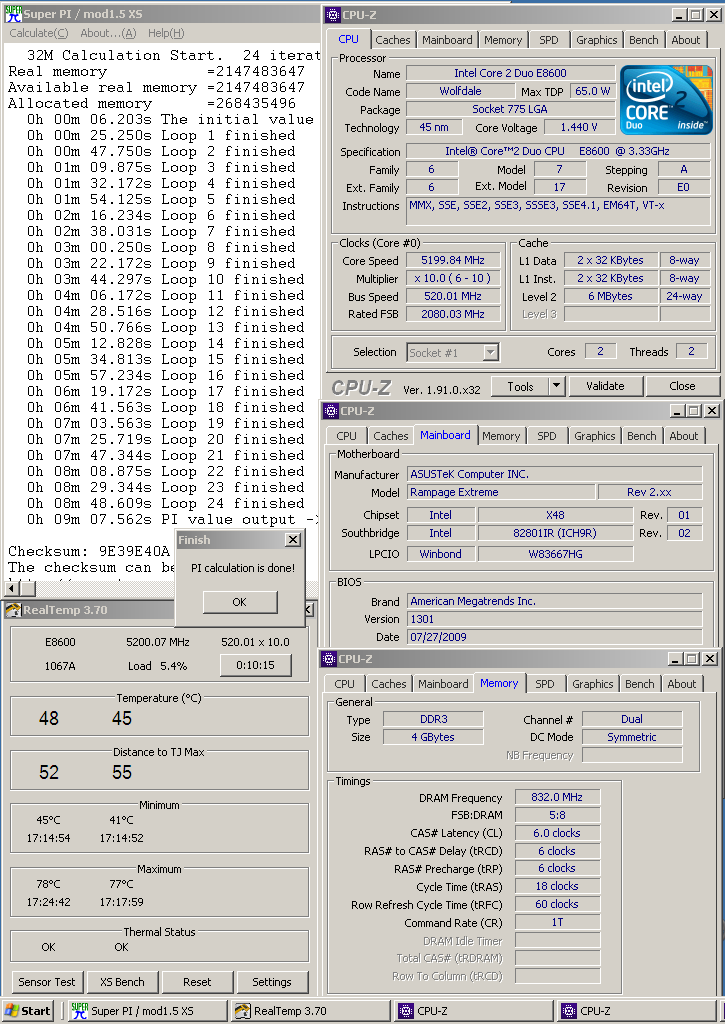-
Posts
3657 -
Joined
-
Last visited
-
Days Won
29
Content Type
Profiles
Forums
Events
Blogs
Posts posted by TaPaKaH
-
-
Yes and no. There are some chips that keep scaling on FSB all the way up to their actual coldbug (as in, lowering FSB won't lower the coldbug) but most chips indeed peak out between -120 and -100 with reverse FSB scaling (similar to Athlon 64 where it is extreme) to be observed when going lower.
-
Is there anything weird or unusual about this CPU that makes it stand out from the rest on ambient?
-
core on air (LinX): 3600 1.40 for an acceptable chip, 1.35 for a good one, 1.30 for an awesome one
core on air (spi 32M): 3900 1.40-1.45 is good for B2, 4000 1.40-1.45 is good for G0
FSB on air: 550 acceptable, 575 good, 600 best
CB is usually -140 to -120Note that low-multi chips (E6300) don't really need good core and high-multi chips (E6600+) have weaker requirements on FSB.
-
 3
3
-
 1
1
-
-
P5E3-Premium randomly died on me today (typical ASUS build quality shit)
bump for R2E
-
 1
1
-
-
Q3QP sold, broken R3E sold. R2E price reduced. Bump

-
Given you use an average single stage with evap temp around -40, I wouldn't call a 5500 1.72 Wolfdale a good sample worth preserving

I would say that at least 30% of random E0 Wolfdales can do this or better. -
6 hours ago, sale_quiche said:
Crazy... But where the f*ck can you buy CPUs by weight ?!

I buy a piece, sell per kg

-
No regrets. The POS got what it deserved.
-
added an R2E and a broken R3E
-
go 9 years back and claim your $2500-3500 "prize" from Taiwan :D
-
also added a damaged Q3QP Gulftown
-
 2
2
-
-
added Gigabyte EX58-Extreme and Gigabyte X58A-UD7
-
 1
1
-
-
added PI 2300C8
EDIT: nevermind, gone in 10 minutes ... free bump for P5E3-Premium, I guess..
-
 2
2
-
 2
2
-
-
-
push for the P5E3-Premium and the dewar
-
Q822A435 no need ...


-
 1
1
-
-
bummer with the shitty VRAM
-
-
wow, almost 3 GHz out of a Willamette stable for an hour
-
 1
1
-
-
bought a piece, sold per kilo .. and only kept one or two, not dozens

-
 1
1
-
-
I tried experimenting with this multiple times in the last decade, but I don't think you can do much better than Hypers on X48. Ultimately, it's all a matter of convenience - the only way to beat ambient Hypers is running cold on your memory. However, given how many more variables it adds to the troubleshooting procedure, how poorly-designed X48 boards are from reliability standpoint, and how difficult good boards are to replace in case of death, it's not really worth the effort.
Still, if we want to have a theoretical discussion:
D9GTR: single-sided sticks usually need high tRFC (60+) above 1025-ish and 1000+ capable dual-sided sticks are impossible to find (I wasn't able to do so in 11 years)
BBSE: on ambient you're likely to hit the same IMC cap as Hypers while running looser tRCD, on cold you can probably do tRCD 6 at 1000-1050 which could be interesting (given that BBSE also like tight-ish tRAS and tRFC)
BDBG / PSC: even on cold you're not likely to go below tRCD 7 at 1050, so you'll be losing to ambient Hypers, especially given that BDBG/PSC run looser tRAS and tRFC-
 3
3
-
 1
1
-
-
so 20 pcs Q822A435 that you already have is not enough?

-
-
Then I would say that a separate category is useless since there is no way to verify which version was used.
Also, I'm not sure if there is any actual practical (=overclocking) difference between the two versions - I had some EE versions of X2 chips and they seemed exactly the same.-
 1
1
-

OGS - Core i7 2600K @ 5965MHz - 5min 33sec 968ms SuperPi - 32M
in Result Discussions
Posted
When is my turn again?